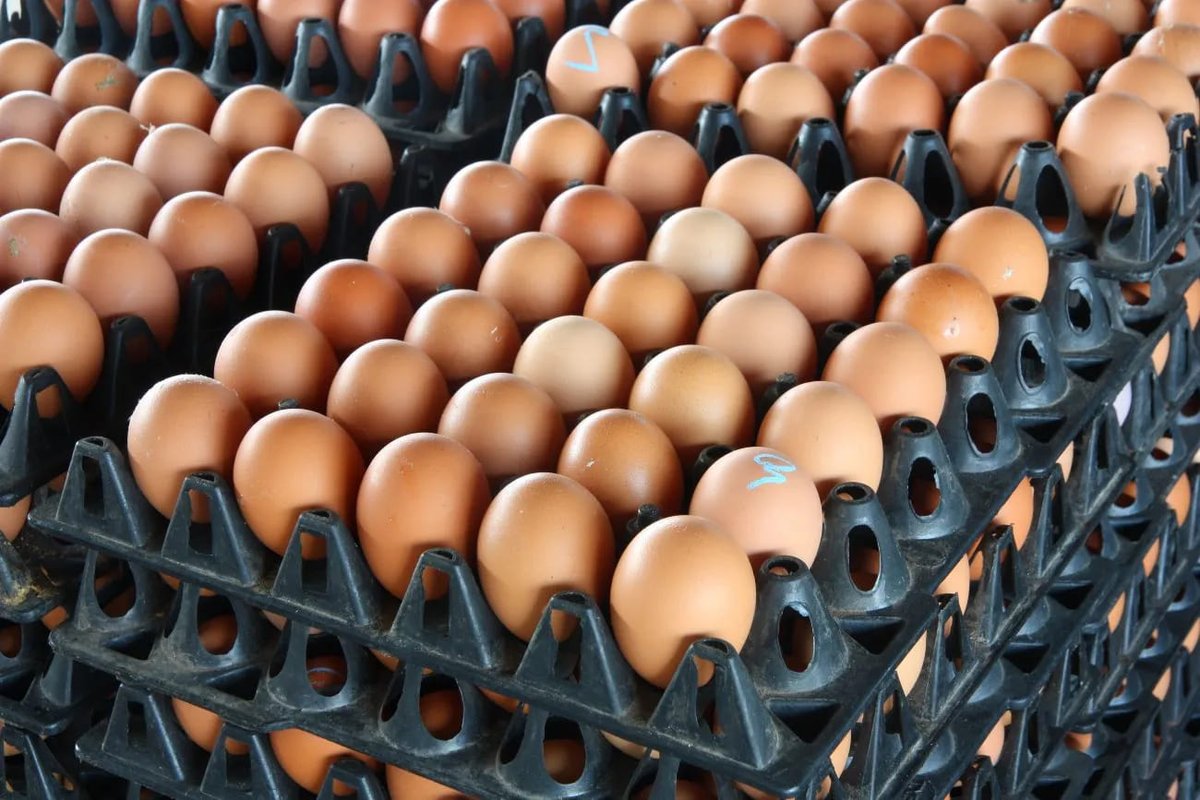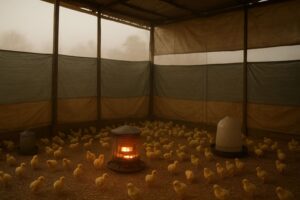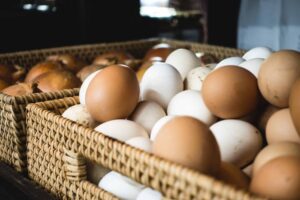At a typical 80% lay rate, 1,000 layers will produce about 800 eggs per day, which equals 26 to 27 crates of eggs. A standard egg crate holds 30 eggs. But that’s just the average. Your actual numbers can swing based on dozens of factors, from the age of your hens to the temperature in your coop. This guide will help you master those variables to understand how many eggs your chickens can produce, how many bags of feed they will consume, and how to accurately calculate your potential profit with our eggs per day calculator for layers.
Use the tables and our simple 1,000 chicken farm profit calculator below to see the numbers for flocks from 20 to 1,000 chickens and learn how to optimize your farm’s output.
How This Guide Helps You
- Who: This guide is written for smallholder and commercial poultry farmers planning their operations.
- How: We use simple, standard formulas and industry averages for our calculations. All assumptions are clearly stated.
- Why: Planning your egg production and feed needs helps you manage inventory, forecast sales, and estimate your net margin more accurately.
Quick Answers
- 1,000 layers at 60%: 600 eggs/day = 20 crates/day
- 1,000 layers at 80%: 800 eggs/day ≈ 26.7 crates/day
- 1,000 layers at 90%: 900 eggs/day = 30 crates/day
- Feed/day baseline: 110 kg (≈242 lb)
- 25‑kg bags: 4.4/day; 50‑kg bags: 2.2/day
- Formulas:
- Eggs/day = hens × hen‑day production (HD%)
- Crates/day = eggs ÷ crate_size
- Feed (kg)/day = hens × 0.11
Note: New to layers? You don’t need a rooster for hens to lay. See: Do I Need a Rooster to Get Eggs?
The Hen-Day Production Formula
For a commercial layer farm, the number of eggs produced each day from a flock of 1,000 chickens is not a fixed number. It’s a dynamic figure that depends heavily on the average daily laying rate of your hens, also known as hen-day production (HD%) (see Hy-Line Management Guide (PDF)). A good way to start is to first understand, do you need a rooster to get eggs?
A simple and highly effective formula to quickly estimate your daily egg production is:
Daily Egg Production = Total Number of Laying Hens x Hen-Day Production (%)
For example, if you have a flock of 1,000 layers with a laying rate of 80%, your daily production would be: 1,000 hens×0.80=800 eggs
How many crates of eggs can 1,000 layers produce?
Many regions use the term “tray” or “flat” to describe a unit of 30 eggs. A “crate” can mean one tray (30 eggs) or a larger box of 12 trays (360 eggs, often called a “case“) in some wholesale markets (e.g., US/Canada).
We default to 30 eggs per crate/tray here. If your market uses 24 or 36, change the crate_size in the formula and calculator. To convert your daily egg count into crates, simply divide the total number of eggs by your local crate size.
- Daily Crates = Total Eggs ÷ Crate Size
- Example at 80%: 800 eggs ÷ 30 = 26.67 crates/day
For regional standards, see USDA egg grading/marketing standards (US) and EU egg marketing standards (EU):
- European Commission – Egg marketing standards
- USDA AMS – Shell egg standards
Crate or Tray Size Varies by Country
Many countries use a tray/flat of 30 eggs. Some wholesalers use a “case,” which is 30 dozen (360 eggs). In this guide, we default to 30 eggs per crate/tray. If your market uses 24 or 36, simply replace “30” in the formulas and calculator. For an example of regional rules on egg sizing and quality, you can refer to USDA egg grading and marketing standards and EU egg marketing standards.
This means your 1,000-layer farm, at an 80% production rate, can produce approximately 26 crates of eggs per day.
This simple formula is a powerful tool for initial planning and daily calculations. In the next section, we’ll dive into how this translates to different flock sizes and what you can expect as you scale your operation.
Poultry Farm Calculator
Projected Profitability
Eggs and Crates by Flock Size: A Scalable View
Understanding hen-day production allows you to project output for any flock size. For instance, have you wondered how many chickens you need for a family of 4?
Eggs per day calculator for layers
Table assumptions: 30‑egg crates; 80% lay rate. Here’s a look at what you can expect from common farm sizes:
| Flock size | Eggs/day | Crates/day | Eggs/week | Crates/month (≈30.4 days) |
|---|---|---|---|---|
| 20 | 16 | 0.53 | 112 | 16.19 |
| 50 | 40 | 1.33 | 280 | 40.53 |
| 100 | 80 | 2.67 | 560 | 81.07 |
| 200 | 160 | 5.33 | 1,120 | 162.13 |
| 500 | 400 | 13.33 | 2,800 | 405.33 |
| 1,000 | 800 | 26.67 | 5,600 | 810.67 |
| 5,000 | 4,000 | 133.33 | 28,000 | 4,053.33 |
How we calculated (assumptions)
- Crate size: 30 eggs (changeable in the calculator)
- Baseline lay rate: 80% (typical daily range 60–90%; peak ~90–95% at 28–35 weeks)
- Feed intake for later section: 0.11 kg/hen/day (110 g)
- Rounding: shown to 2 decimals for crates
How many eggs will 100 chickens lay in a day?
As the table shows, a flock of 100 chickens with a typical 80% hen-day production will lay approximately 80 eggs per day, which is equivalent to 2.67 crates. Getting this consistent output requires the right setup, including properly designed nesting boxes: size, materials, placement. Understanding the entire commercial layer egg production curve is key to long-term planning.
As you move from a small-scale to a large-scale operation, the numbers become more significant, but so do the challenges. A small-scale farmer with 50 birds may find their operation manageable with minimal labor, while a 1,000-layer farm requires significant investment in infrastructure, feed management, biosecurity, and hired hands. The jump from 500 to 1,000 layers, for instance, often means shifting from manual to semi-automated feeding systems and a more rigorous vaccination schedule.
The key takeaway here is that profitability is not just about flock size, but about maintaining that optimal hen-day production rate. Let’s now explore the crucial factors that influence how many eggs your hens will actually lay.
How Many Eggs Will 1,000 Layers Lay a Day? The Hen-Day Production Curve
While we use 80% as a good benchmark, a hen’s laying life is a journey with different stages of production. A pullet (young hen) will typically start laying at around 18-22 weeks of age. Egg production will gradually increase, reaching a peak of around 90-95% hen-day production between 28-35 weeks. After this peak, the rate will slowly decline by about 0.5% each week.
What Factors Influence the Hen-Day Production Curve?
The rate at which your hens produce eggs is directly tied to their overall health and environment. While the genetic potential of the breed sets the maximum possible lay rate, your management practices determine how close you get to that potential. Key factors include:
- Age and Strain: Different breeds (strains) have different peak production rates and persistency.
- Nutrition: A balanced diet is non-negotiable.
- Water Availability and Quality: Dehydration, even slight, will halt production.
- Lighting Program: Consistent light duration is essential for stimulating egg production.
- Housing and Ventilation: Proper airflow and protection from heat are critical in tropical regions.
- Biosecurity and Disease Management: A healthy hen is a productive hen.
The journey from a day-old chick to a peak-producing hen is a carefully managed process. To ensure you hit that 90% peak, you need to understand and control these factors. Two common production killers are molting season and production dips and broodiness, which you can break to maintain lay. The next section will focus on the single largest operational cost: feed.
How Many Bags of Feed Will 1,000 Layers Consume Per Day? | Climate & Feed Management
Feed accounts for over 70% of the total cost of running a poultry farm. A typical commercial layer will consume an average of 110-120 grams of feed per day (see Lohmann Management Guide (PDF) or the ISA Layers Management Guide (PDF)). For our calculations, we will use a baseline of 0.11 kg/hen/day (0.11 kg, or 110 g). A comprehensive feeding guide for chickens can help you get started.
- Formula for Daily Feed Consumption: Daily Feed Consumption (kg) = Number of Hens x Average Daily Feed Intake (kg)
- Example: 1,000 hens×0.11 kg/hen=110 kg (242 lb) of feed
Units
- Total Feed: 110 kg (≈242 lb)
- Bags: 25 kg (55 lb), 50 kg (110 lb)
- Optional Outputs: 20 kg (44 lb), 40 kg (88 lb), 45 kg (99 lb)
A standard bag of layer mash is 25 kg. Therefore: 110 kg÷25 kg/bag=4.4 bags of feed
A 1,000-layer farm will consume approximately 4 to 5 bags of feed per day. This number will be higher during the cooler periods of the day as hens eat to maintain body heat, and lower during the heat of the day when they pant to cool down. A proper feeding schedule for consistent lay can help you manage this.
Feed Consumption by Bag Size
To make it easy for you to calculate based on your local market, here’s how many bags you’ll need depending on the size:
- 20 kg (44 lb) bags: 110÷20=5.5 bags per day
- 40 kg (88 lb) bags: 110÷40=2.75 bags per day
- 45 kg (99 lb) bags: 110÷45=2.44 bags per day
- 50 kg (110 lb) bags: 110÷50=2.2 bags per day
Feed Management in Tropical Climates: A Crucial Adjustment
In hot and humid tropical climates, hens eat less but still require the same nutrient density to produce eggs. This makes feed formulation a critical skill. To maintain performance and mitigate heat stress in laying hens, you should:
- Increase Nutrient Density: Add more fats and oils to the feed. Fats have a lower heat increment, meaning they produce less body heat when digested. Learn more about what to feed chickens during a heatwave.
- Adjust Protein and Amino Acids: Ensure the diet has a balanced profile of essential amino acids, particularly lysine and methionine, as protein synthesis is affected by heat stress.
- Manage Electrolyte Balance: Add electrolytes like sodium bicarbonate and potassium chloride to the water or feed to replenish what is lost through panting.
Temperate/Cold Weather
Intake often rises 5–10% in cold spells. Keep water above 10°C (50°F) to maintain intake. Ensure draft‑free but well‑ventilated housing; maintain a consistent ~16 hours of light/day to support production. In very hard winters, consistently adding grit or oyster shells can improve shell quality. Knowing how to winterize your coop can prevent many issues.
Maintaining an optimal feed program, especially in a tropical climate, is the most direct way to protect your profit margins. With feed costs managed, let’s look at the full picture of a 1,000-layer farm’s finances.
1,000 Chicken Farm Profit Breakdown: A Detailed Financial Overview
A basic profit calculator for a 1,000-layer farm must consider both revenue and a comprehensive list of expenses. For a first-time farmer, it’s helpful to consider the cost to raise chickens for the first year. For those considering a hobby, it’s worth asking is raising chickens cheaper than buying eggs?
Key Revenue Streams
- Egg Sales: This is your primary income. For US readers, it’s important to understand how to legally sell eggs (including permits and labeling) as state-specific chicken laws can vary.
- Spent Hen Sales: After about 72 weeks of age, layers are culled and sold for meat.
- Manure Sales: Poultry manure is a valuable fertilizer for local farmers.
Critical Cost Breakdown
The costs of a 1,000-layer farm can be broken down into capital and operational expenses. Please input your local currency symbol and ISO code to get a more accurate projection.
- Capital Costs (One-time):
- Housing: A deep litter system is common and cost-effective in the tropics. A good rule of thumb is 2-4 birds per square meter, so a 1,000-bird house needs at least 250 square meters (2,690 sq ft).
- Equipment: Feeders, drinkers, lighting, perches, and nest boxes.
- Day-old Chicks (DOC): The initial cost of your 1,000 pullets.
- Operational Costs (Recurring):
- Feed: The largest expense, with different rations needed for starter, grower, and layer phases. Use our chicken feed calculator and cost guide to forecast your monthly expenses.
- Medication & Vaccination: A proper vaccination schedule is essential to prevent diseases like Newcastle Disease and Gumboro.
- Labor: At least one full-time farmhand is needed for a 1,000-layer farm.
- Utilities: Electricity for lighting and water pumps.
- Miscellaneous: Bedding/litter material, disinfectants, and replacement of old equipment.
Understanding all these financial inputs and outputs is the difference between a hobby and a profitable business. Next, we’ll take a deep dive into the environmental and biological factors that directly impact your hens’ ability to produce.
Key Factors That Change Lay Rate: A Deep Dive for Farmers
In all climates, managing environmental factors is paramount to a successful poultry operation.
Housing and Ventilation: Building for Success
Poultry cannot sweat, so they rely on panting to cool down. This process is highly inefficient and leads to reduced feed intake. Proper housing design is the single most important factor in mitigating this. Understanding coop ventilation mistakes is crucial.
- For Hot and Humid Regions (e.g., West Africa, Southeast Asia): Position your chicken house east-west to minimize direct sunlight exposure during the hottest parts of the day. Opt for naturally ventilated, open-sided structures with wire mesh to allow for maximum airflow. A high roof (at least 3 meters or 10 ft) with a good overhang provides shade and allows hot air to escape more easily. Use a white-painted roof to reflect sunlight. The best place to put your coop can make a big difference.
- For Cold and Temperate Regions (e.g., Northern Europe, Canada): In cold weather, feed intake may increase by 5–10% as birds eat to maintain body temperature. Ensure your coop has draft-free ventilation to prevent moisture buildup while keeping the birds warm. Make sure their water does not drop below 10°C (50°F). In very hard winters, consistently adding grit or oyster shells can improve shell quality. You may also need to know how to prevent frostbite on combs for some breeds.
- Year-Round: A good lighting program is critical. Hens require about 16 hours of light per day for optimal egg production. Don’t decrease the photoperiod in the middle of a laying cycle, as this can halt production. Proper management, like learning how to get chickens back in the coop at night, also reduces stress and improves flock behavior.
Proper ventilation and protection from the elements are not just about hen comfort; they directly translate to egg production and hen livability. Let’s move on to the biological side of hen management.
Breed Selection: Choosing the Right Bird for Any Climate
Not all chickens are created equal. Some breeds are more suited to withstanding heat and humidity, while others are more cold-hardy. While many commercial strains are bred for high production, they may struggle under stress. Some well-regarded, heat-tolerant breeds for egg-laying include:
- Rhode Island Red: A robust and highly productive breed that can tolerate both hot and cold climates.
- White Leghorn: Known for its high egg output and smaller body size, which makes it more heat-tolerant.
- Golden Comet: A hybrid known for its calm demeanor and consistent production even in the heat.
- Fayoumi: A breed that originated in Egypt, making it naturally adapted to hot climates.
For beginners, consider the easiest breeds to raise, or if you have close neighbors, the quietest chicken breeds. For more in-depth breed information, check out our guides on the Wyandotte and Buff Orpington.
Selecting the right strain for your environment is the first step to a productive and healthy flock. From there, it’s all about keeping them healthy.
Biosecurity and Disease Prevention: Protecting Your Investment
High temperatures and humidity can be a breeding ground for pathogens. A strong biosecurity plan for poultry farms is your first line of defense against devastating diseases. Knowing how to handle issues like respiratory infections is crucial.
- Vaccination Schedule: Consult with a local veterinarian to establish a rigorous vaccination program for common diseases in your region, such as Newcastle Disease (NCD), Infectious Bronchitis (IB), and Gumboro. For an overview of these common layer diseases, refer to the Merck Veterinary Manual. For general care, performing a regular chicken health check can help you spot problems early.
- Footbaths: Install footbaths with disinfectants at the entrance of your farm to prevent the spread of diseases from outside. Flies and biosecurity are also a key concern.
- Hygiene: Regularly clean and disinfect all equipment, feeders, drinkers, and housing. Ensure the litter is kept dry to prevent coccidiosis. You can also learn how to keep rats out of the coop as they can spread disease and eat eggs and feed.
- Quarantine: Isolate any new birds for at least two weeks before introducing them to the main flock. Also, being prepared with predator-proofing 101 can save your flock.
Your biosecurity measures are the foundation of a healthy farm. A single disease outbreak can wipe out a flock and years of investment in just a few days. Finally, let’s talk about the fuel that powers it all: feed and water.
Nutrition and Water: The Foundation of Production
A hen’s body is over 70% water, and an egg is over 75% water. As such, an unlimited supply of cool, clean water is non-negotiable.
- Water Management: In hot climates, hens drink significantly more water. Ensure they have constant access to fresh water. Consider installing an automatic water system to reduce labor and maintain cleanliness.
- Feed Quality: The quality of your feed is directly linked to the quality of your eggs. Source your ingredients locally where possible, such as maize, soybeans, and palm kernel cake. Always check for quality and store feed in a cool, dry place to prevent mold growth, which can be toxic. For a nutritional boost, learn about fermenting chicken feed.
Frequently Asked Questions
How many eggs will 100 chickens lay in a day?
As the table shows, a flock of 100 chickens with a typical 80% hen-day production will lay approximately 80 eggs per day, which is equivalent to 2.67 crates.
How many crates of eggs can 1,000 layers produce?
A typical flock of 1,000 layers will produce about 800 eggs per day at an 80% lay rate, which is equivalent to 26 to 27 standard 30-egg crates.
Do hens lay fewer eggs in winter?
Yes, without supplemental light. Maintain ~16 hours of light/day to support production.
Eggs per day calculator for layers: how do I use it?
Enter your flock size, lay rate (HD%), and your local crate/tray size. The tool outputs eggs/day, crates/day, feed/day, and optional profit.
Why have my chickens stopped laying eggs?
A sudden drop in egg production can be due to a number of factors, including the age of your hens (production naturally declines after peak), molting (shedding and regrowing feathers), stress from heat or predators, a change in feed or water quality, or illness. A decrease in daylight hours can also trigger a pause in laying.
What is a profitable egg price per crate?
Profitability depends on your local costs, particularly the price of feed and labor. A good rule of thumb is that your egg sales should generate a significant margin over your feed costs. Use the profit calculator in this guide to input your local numbers and see how they impact the bottom line.
What are the most common diseases in poultry?
Common diseases that can affect egg production include Newcastle Disease (NCD), Infectious Bronchitis (IB), and Gumboro. A strict biosecurity program and a proper vaccination schedule are the most effective ways to prevent these diseases and protect your flock.
Conclusion
Mastering a poultry operation, whether small or large, is a rewarding challenge. By focusing on the core principles of hen-day production, optimizing your feed management, and ensuring a healthy, secure environment, you can turn a flock into a profitable and sustainable business. The numbers in this guide are a starting point, but by using the formulas and calculators, you can tailor the plan to your specific farm and local market.
We hope this guide provides you with the insights and confidence needed to succeed. Feel free to ask more questions as you continue your journey.
Related Guides
Feeding and Costs
- Chicken Feed Calculator & Cost Guide
- The Best Feeding Schedule for Backyard Chickens
- Calcium for Chickens: The Ultimate Guide
Improve Egg Output
- Chicken Molting Season: What to Expect
- Break a Broody Hen (Without Stress)
- 17 Coop Ventilation Mistakes That Overheat Your Flock
Health & Safety
- Chicken Health Check: Weekly Routine
- Mites and Lice on Chickens: Identification and Treatment
- Predator‑Proofing 101: Easy Fixes for a Safer Coop
Legal & Planning
- How to Legally Sell Your Backyard Chicken Eggs
- Chicken Laws by State (USA)
- Cost to Raise Chickens for the First Year
Country-specific guides
- Broilers vs Layers Profit (Nigeria)
- Poultry Farming Business Plan (Nigeria)
- Start Profitable Broiler Farming in Nigeria
- Layer Farming Business (Nigeria)

Oladepo Babatunde is the founder of ChickenStarter.com. He is a backyard chicken keeper and educator who specializes in helping beginners raise healthy flocks, particularly in warm climates. His expertise comes from years of hands-on experience building coops, treating common chicken ailments, and solving flock management issues. His own happy hens are a testament to his methods, laying 25-30 eggs weekly.



